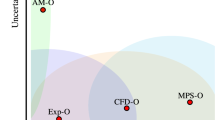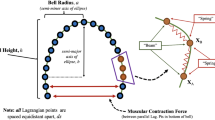Abstract
Monofins provide swimmers with an efficient alternative to the standard pair of fins. For example, all short and long distance human swimming records have been established using monofins. Current monofin design is mostly empirical, so the objectives of this work are to analyze monofin propulsion through coupled fluid–structure simulation and to optimize its flexural stiffness distribution. The optimization process maximizes the propulsive power provided by the monofin with a constraint on the total expended power. To be able to carry out the optimization of the coupled fluid–structure system, which is numerically costly to evaluate, the following simplifications are proposed: (1) a 2-D unsteady, inviscid, and incompressible fluid flow is considered; (2) the swimmer is composed of linear articulated segments, whose kinematics is imposed and identified from experimental data; and (3) the monofin is represented by rigid bars linked by torsional springs. For various allowable swimmer powers, optimal 2-D stiffness distributions are obtained using the Globalized and Bounded Nelder–Mead algorithm. Finally, an identification procedure is described to translate the optimal 2-D stiffness distributions into 3-D thickness profiles for a given monofin planform shape.
Similar content being viewed by others
References
Anderson J, Streitlien K, Barret D, Triantafyllou M (1998) Oscillating foils of high propulsive efficiency. J Fluid Mech 360:41–72
Baly L, Durey A, Favier D (2001) Etude des fréquences et amplitudes ondulatoires chez le nageur avec palmes de haut niveau. Journées de l’Ecole Doctorale des Sciences de la Vie et de la Santé, Univ de Méditerranée, France URL http://www.ujf-grenoble.fr/ufraps/acaps/Actes/Poster/baly.pdf
di Prampero P, Pendergast D, Wilson D, Rennie D (1974) Energetics of swimming in man. J Appl Physiol 37(1):1–5
Géradin M, Cardona A (2001) Flexible multibody dynamics: a finite element approach. Wiley, New York, USA
Kvamsdal T, Jenssen C, Okstad K, Amundsen J (1999) Fluid–structure interaction for structural design. In: Kvamsdal T et al (ed) Proc Int Symp on Comput Methods for Fluid-Structure Interaction (FSI’99), 15–17 February 1999. Tapir Publishers, Trondheim, Norway pp 211–238
Le Maître O, Huberson S, Souza de Cursi E (1999) Unsteady model of sail and flow interaction. J Fluids Struct 13:37–59
Lemosse D, Dhatt G (2000) Study of shell-like structures by brick finite element model. In: Proceedings of the fifth international conference on computational structures technology, Leuven, Belgium, 6–8 September 2000, vol. H, pp 183–190
Luersen M, Le Riche R, Le Maître O, Breier E (2003) Optimisation de monopalmes de nage. In: Proceedings of the 6th Colloque National en Calcul des Structures, Giens, France, 20–23 May 2003, vol 3, pp 207–214
Luersen M, Le Riche R, Guyon F (2004) A constrained, globalized, and bounded nelder–mead method for engineering optimization. Struct Multidiscipl Optim 27:43–54
Nelder J, Mead R (1965) A simplex for function minimization. Comput J 7:308–313
Pedro G, Suleman A, Djilali N (2003) A numerical study of propulsive efficiency of flapping hydrofoil. Int J Numer Methods Fluids 42:493–526
Sfakiotakis M, Lane D, Davies B (1999) Review of fish swimming modes for aquatic locomotion. IEEE J Oceanic Eng 24(2):237–252
Zamparo P, Pendergast D, Termin B, Minetti A (2002) How fins affect the economy and efficiency of human swimming. J Exp Biol 205:2665–2676
Author information
Authors and Affiliations
Corresponding author
Rights and permissions
About this article
Cite this article
Luersen, M.A., Le Riche, R., Lemosse, D. et al. A computationally efficient approach to swimming monofin optimization. Struct Multidisc Optim 31, 488–496 (2006). https://doi.org/10.1007/s00158-006-0001-6
Received:
Published:
Issue Date:
DOI: https://doi.org/10.1007/s00158-006-0001-6




